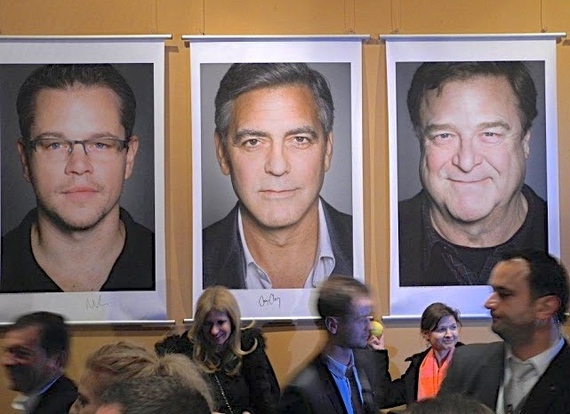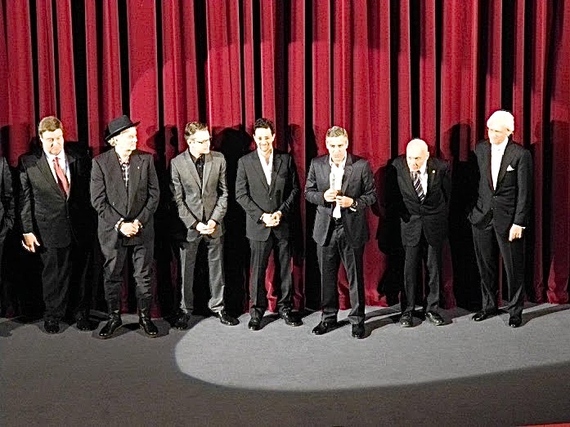
Signed mugshots featuring Matt Damon, George Clooney, and John Goodman at the world premiere of The Monuments Men at the Palast Theater in Berlin.
In this city, so close to the story of George Clooney's new movie, The Monuments Men, the audience has come out in droves. The world premiere opened to a packed, tripled-tiered Palast Theater at the Berlinale film festival- not an empty seat in the house.
And why stop at honoring the stars? In a gesture reflecting Mr. Clooney's big-heartedness, the red carpet treatment extended to the last living member of the Monuments Men, born in 1926- Harry Ettlinger stood wide-eyed as a deer in the flash of the camera lights.
The story of The Monuments Men is encapsulated in the opening sequence, a slow montage of paintings, each a gemstone of European art. The immaculate images are accompanied by a jarring soundtrack- resolute, systematic wallops suggest the finality of nails driven into a coffin lid. Like much that was jeopardized, the artworks impounded by the Nazis may or may not survive the war.
The Monuments Men, based on a book of the same title by Robert Edsel and Bret Witter, is written, directed, and stared in by George Clooney. In making this choice, Mr. Clooney focuses on a particular aspect of WWII. The film addresses not the devastating loss and ruination of human lives, but the missing art. Where have tens of thousands of artworks gone?
George Clooney plays Frank Stokes, based on George Stout of The Fogg Museum at Harvard. Backed by President Roosevelt, Stout and a group of men were charged with recouping and protecting the mass of priceless art.
Hitler, in his madness, planned to open a museum in his hometown of Linz, Austria, where he would house a grand collection of the finest jewels in the European art crown. With a lunatic's zeal, he collected everything in sight. And since these artworks were already owned, his requisitioning required special means- taxing, looting, and outright theft.
A band of men were tasked with finding the missing paintings, drawing and sculpture. A hand-picked group of museum curators, architects, designers and artists are played by Bill Murray, Matt Damon, John Goodman, Jean Dujardin, Hugh Bonneville, and Bob Balaban. Together, they comprise a group of unlikely soldier-detectives that nonetheless locate a lot of the missing art, much of it squirreled away in Austrian salt mines. The caves are the perfect spot for art storage- cavernous labyrinths that were hidden and dry (salt absorbs moisture.)
The cave's holdings are vast, and make for some of the most interesting shots in the movie, like the dust-covered but serene Michelangelo sculpture, the Madonna of Bruges, and the superb Ghent altarpiece. At the end of the war, the Nazis return to one of the caves before the Allies arrive, and in a monumental act of cultural suicide, torch the contents, sending countless artworks up in flames.
The material of the source book is almost as big and unwieldy as some of the art, and the script suffers from trying to include too much. It unfolds as a rather bumpy collection of scenes lacking a smooth story arc. Perhaps Mr. Clooney writes too much from the perspective of a screen actor, who performs single scenes, often out of sequence.
The strongest scene in the film is one between the Clooney character, Stokes, and a commanding Nazi officer at the end of the war who has just told Stokes he should be grateful that so many Jews have been killed. Stokes responds that he looks forward to going home and eating a toasted onion bagel at Sid's delicatessen in New York while he reads in the newspaper about the Nazi being sentenced to death for war crimes.
The loss of artworks in war is worth lamenting. While they may not involve personal suffering, they constitute an enormous collective loss. Because when its people are dead and buried, isn't a society assessed by its art? Surviving artifacts are the legacy of a civilization- King Tut's tomb, the Greek Parthenon, the Roman Forum. Art, architecture, music, plays and philosophy (and movies) tell us not just who those people were then, but in western culture, where we're coming from now.
In China, where Chairman Mao decreed a 'cleansing' during his Cultural Revolution and ordered the destruction of existing art and architecture, today's Chinese flock by the tens of thousands to the few buildings saved by Chiang Kai-shek like the Imperial Palace in Beijing, designated as a World Cultural Heritage Site. Their thirst for their cultural past is enormous.
Cate Blanchett plays Claire Simone, based on the real Rose Valland, a curator at the Jeu de Paume modern art collection in Paris who documented the whereabouts of looted art, providing invaluable information for locating art after the war. In her wire-rimmed glasses and straight skirt, she is prim and proper, despite her flirtation with the Matt Damon character, providing the requisite love interest.
While some may say that The Monuments Men aims too low, that its Hogan's-Heroes-meets-M.A.S.H tenor is too populist, perhaps that's exactly what's needed. In our era of glorifying sports players, when most Americans can name an NFL quarterback before they can name a Renaissance painter, when the persistent cloud of endless war hangs over us, maybe it's a good thing that The Monuments Men can reach a mainstream audience about the importance of art, how easily it is lost, and what we should do to protect it.

Harry Ettlinger (second from right), the last living monuments man, introduced by George Clooney at the world premiere of The Monuments Men in Berlin.